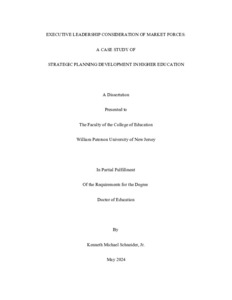Please use this identifier to cite or link to this item:
http://hdl.handle.net/20.500.12164/3438| Title: | Executive Leadership Consideration of Market Forces: A Case Study of Strategic Planning Development in Higher Education |
| Authors: | Schneider, Kenneth M. Jr. |
| Keywords: | Education;Educational leadership;Higher education institutions;Market forces;Strategic planning;Five Forces;Porter |
| Issue Date: | 13-May-2024 |
| Publisher: | William Paterson University |
| Abstract: | This case study explored the consideration, inclusion, and significance of market forces in the development of strategic planning at higher education institutions. The design examined methods, procedures, behaviors, and attitudes that Presidents in higher education applied to designing strategic planning processes. Guiding this examination was the Five Forces Model by Michael Porter (1980), a business model that uses market forces to measure success. The results supported the notion that students act as consumers. This concept was a driving force in the development of strategic planning and points to the external lens necessary for strategic planning. Additionally, the results suggested that the key role of the President in forging both the completion and execution of strategic plans. This highlighted a connection between the external view necessary for successful planning with the internal characteristics of the President’s role. This dynamic suggested that the President acted as both an originator of market force awareness and as the campaigner for infusing market forces into the strategic planning process. Executive leadership needs to center on the notion that higher education institutions operate in a consumer driven market. This may render traditional processes of strategic planning obsolete, considering the challenges facing the industry. This case study may be vital for understanding how higher education leaders engage in contemporary strategic planning that promotes viability amid the ongoing concerns inherent in a hypercompetitive environment. Future consideration of a contemporary framework based on Porter’s model (1980) may assist to create strategic plans driven by market forces for institutions with insufficient institutional planning. |
| URI: | http://hdl.handle.net/20.500.12164/3438 |
| Appears in Collections: | Theses & Dissertations |
Files in This Item:
| File | Description | Size | Format | |
|---|---|---|---|---|
| Schneider_HigherEdStrategicPlanning.pdf | 712.29 kB | Adobe PDF |  View/Open |
Items in DSpace are protected by copyright, with all rights reserved, unless otherwise indicated.
